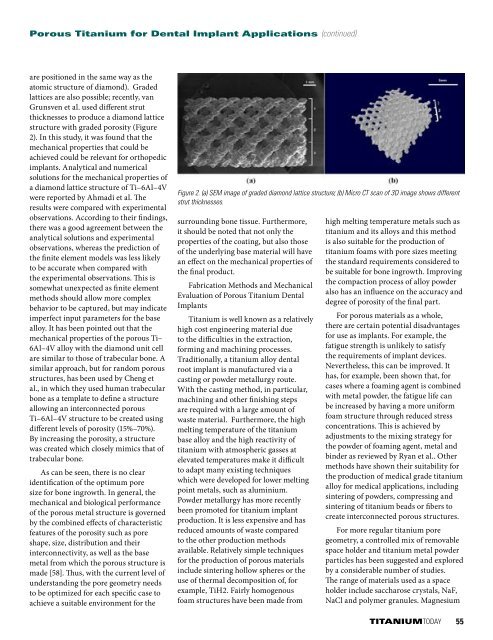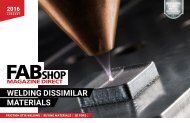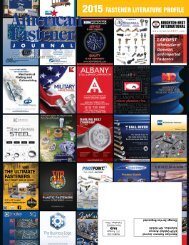100% Positive Material Identification
23mhiW2
23mhiW2
Create successful ePaper yourself
Turn your PDF publications into a flip-book with our unique Google optimized e-Paper software.
Porous Titanium for Dental Implant Applications (continued)<br />
are positioned in the same way as the<br />
atomic structure of diamond). Graded<br />
lattices are also possible; recently, van<br />
Grunsven et al. used different strut<br />
thicknesses to produce a diamond lattice<br />
structure with graded porosity (Figure<br />
2). In this study, it was found that the<br />
mechanical properties that could be<br />
achieved could be relevant for orthopedic<br />
implants. Analytical and numerical<br />
solutions for the mechanical properties of<br />
a diamond lattice structure of Ti–6Al–4V<br />
were reported by Ahmadi et al. The<br />
results were compared with experimental<br />
observations. According to their findings,<br />
there was a good agreement between the<br />
analytical solutions and experimental<br />
observations, whereas the prediction of<br />
the finite element models was less likely<br />
to be accurate when compared with<br />
the experimental observations. This is<br />
somewhat unexpected as finite element<br />
methods should allow more complex<br />
behavior to be captured, but may indicate<br />
imperfect input parameters for the base<br />
alloy. It has been pointed out that the<br />
mechanical properties of the porous Ti–<br />
6Al–4V alloy with the diamond unit cell<br />
are similar to those of trabecular bone. A<br />
similar approach, but for random porous<br />
structures, has been used by Cheng et<br />
al., in which they used human trabecular<br />
bone as a template to define a structure<br />
allowing an interconnected porous<br />
Ti–6Al–4V structure to be created using<br />
different levels of porosity (15%–70%).<br />
By increasing the porosity, a structure<br />
was created which closely mimics that of<br />
trabecular bone.<br />
As can be seen, there is no clear<br />
identification of the optimum pore<br />
size for bone ingrowth. In general, the<br />
mechanical and biological performance<br />
of the porous metal structure is governed<br />
by the combined effects of characteristic<br />
features of the porosity such as pore<br />
shape, size, distribution and their<br />
interconnectivity, as well as the base<br />
metal from which the porous structure is<br />
made [58]. Thus, with the current level of<br />
understanding the pore geometry needs<br />
to be optimized for each specific case to<br />
achieve a suitable environment for the<br />
Figure 2. (a) SEM image of graded diamond lattice structure; (b) Micro CT scan of 3D image shows different<br />
strut thicknesses.<br />
surrounding bone tissue. Furthermore,<br />
it should be noted that not only the<br />
properties of the coating, but also those<br />
of the underlying base material will have<br />
an effect on the mechanical properties of<br />
the final product.<br />
Fabrication Methods and Mechanical<br />
Evaluation of Porous Titanium Dental<br />
Implants<br />
Titanium is well known as a relatively<br />
high cost engineering material due<br />
to the difficulties in the extraction,<br />
forming and machining processes.<br />
Traditionally, a titanium alloy dental<br />
root implant is manufactured via a<br />
casting or powder metallurgy route.<br />
With the casting method, in particular,<br />
machining and other finishing steps<br />
are required with a large amount of<br />
waste material. Furthermore, the high<br />
melting temperature of the titanium<br />
base alloy and the high reactivity of<br />
titanium with atmospheric gasses at<br />
elevated temperatures make it difficult<br />
to adapt many existing techniques<br />
which were developed for lower melting<br />
point metals, such as aluminium.<br />
Powder metallurgy has more recently<br />
been promoted for titanium implant<br />
production. It is less expensive and has<br />
reduced amounts of waste compared<br />
to the other production methods<br />
available. Relatively simple techniques<br />
for the production of porous materials<br />
include sintering hollow spheres or the<br />
use of thermal decomposition of, for<br />
example, TiH2. Fairly homogenous<br />
foam structures have been made from<br />
high melting temperature metals such as<br />
titanium and its alloys and this method<br />
is also suitable for the production of<br />
titanium foams with pore sizes meeting<br />
the standard requirements considered to<br />
be suitable for bone ingrowth. Improving<br />
the compaction process of alloy powder<br />
also has an influence on the accuracy and<br />
degree of porosity of the final part.<br />
For porous materials as a whole,<br />
there are certain potential disadvantages<br />
for use as implants. For example, the<br />
fatigue strength is unlikely to satisfy<br />
the requirements of implant devices.<br />
Nevertheless, this can be improved. It<br />
has, for example, been shown that, for<br />
cases where a foaming agent is combined<br />
with metal powder, the fatigue life can<br />
be increased by having a more uniform<br />
foam structure through reduced stress<br />
concentrations. This is achieved by<br />
adjustments to the mixing strategy for<br />
the powder of foaming agent, metal and<br />
binder as reviewed by Ryan et al.. Other<br />
methods have shown their suitability for<br />
the production of medical grade titanium<br />
alloy for medical applications, including<br />
sintering of powders, compressing and<br />
sintering of titanium beads or fibers to<br />
create interconnected porous structures.<br />
For more regular titanium pore<br />
geometry, a controlled mix of removable<br />
space holder and titanium metal powder<br />
particles has been suggested and explored<br />
by a considerable number of studies.<br />
The range of materials used as a space<br />
holder include saccharose crystals, NaF,<br />
NaCl and polymer granules. Magnesium<br />
TITANIUMTODAY 55







